![]()
![]()
![]()
Use LEFT and RIGHT arrow keys to navigate between flashcards;
Use UP and DOWN arrow keys to flip the card;
H to show hint;
A reads text to speech;
89 Cards in this Set
- Front
- Back
|
There are three copies made of the patient report form, where are they sent to? |
White copy: Given to ambulance service Yellow copy: kept securely on station Green copy: given to IEC program manager |
|
|
What does A.V.P.U used to measure level of response stand for? |
A : is the patient alert? V: does the patient respond to voice canards? P: Does the patient respond to pain stimulus? U: if there is no response to voice or pain, they are unresponsive |
|
|
What is the Glasgow Coma scale? |
A scale made by Glasgow university used to measure the consciousness of a patient. Scores can range from 3-15 |
|
|
How do you record the score of the Glasgow Coma Scale? |
•Add all the numbers for each category •The patients level of response may deteriorate over time so it must be monitored and changes must be noted |
|
|
Does the Results from the Glasgow Coma Scale have to be recoded on the Patient Report Form? |
Yes, and it must be noted in this format- Time “0000” Eye opening- result Verbal Response- result Motor Response- result Total-result |
|
|
How often must the respiratory rate and pulse rate be checked? |
Every 3 minutes |
|
|
What are the Average Respiratory Rates per minute for an Adult, Child and Infant |
Adult: 12-30 Child: 20-30 Infant: 30+ |
|
|
What are the Average Pulse Rates per minute of an Adult, Child and Infant |
Adult: 60-80 Child: 100-140 Infant: 140+ |
|
|
What are the three common sites used to acquire a pulse? |
Carotid: usually used during cardiac arrest. Located in the neck. Radial: Located in the wrist Brachial: used for paediatrics. Located in bicep. |
|
|
What is the Pulse Oximeter? |
A tool used to record Oxygen percentage and Oxygen Saturation (SpO2) |
|
|
What are the Factors that affect the accuracy of a Pulse Oximeter? |
•Bright Sunlight •Nail Varnish •Shivering/Movement •Poor Tissue perfusion •Corbin monoxide poisoned victims will display normal SpO2 levels |
|
|
How do you operate a Pulse Oximeter? |
•Clip on patients Finger between rubber cushions •Wait 10-20 secs for stable reading •Record reading under pulse rate and SpO2 level on both normal air and post O2 treatment. |
|
|
What is Capillary Refill and how do you check it? |
Capillary Refill is the the technique used to check circulation. It is check by pinching the flesh of a finger tip for five seconds and counting the time taken for skin colour to return to normal. 2 seconds and under is good circulation. |
|
|
What is the digital Ear thermometer? |
A device used to measure a patients Core Temperature |
|
|
How do you use a Digital Ear Thermometer |
•Press on/recall to turn the device on •Wait till device displays “00.0 degrees Celsius” •Straighten ear canal by pulling outer ear: back for infants, back and up for ages 1-adult •Insert, press scan and wait till a temperature is displayed •Record Value on Patient report form “temp=0.00 degrees Celsius” and dispose of plastic cap |
|
|
What do you do with defective devices? |
Return to IEC Program Manager and replacement should be ordered on POMs |
|
|
What is A.T.M.I.S.T |
Age Time of Incident Mechanism of Injury Injury Signs and Symptoms Treatment given |
|
|
What is A.T.M.I.S.T |
Age Time of Incident Mechanism of Injury Injury Signs and Symptoms Treatment given |
|
|
S.A.M.P.L.E is used to handover medical patients to Paramedics. What is S.A.M.P.L.E |
Signs and Symptoms Allergies Medication Past Medical History Last ate/drank Event and environment of incident |
|
|
What is the Respiratory System |
It is the system the provides the route which the supply of oxygen present in the atmospheric air enters the lungs and the route for the excretion of CO2 |
|
|
What are the principle functions of respiration |
•Take in oxygen from atmosphere and transfer it to bloodstream •Excrete water vapour and CO2 •Maintain normal acid-base status of blood •Ventilate the lungs |
|
|
What are the 9 organs of the respiratory System |
•Nose •Pharynx •Larynx •Trachea •Two Bronchi •Bronchioles and Smaller Passages •Two Lungs pleura •Intercostal Muscles •Diaphragm |
|
|
What is the nasal Cavities job |
It is the main route of entry, it warms filters cleans and humidifies the inhaled air |
|
|
What is the job of the pharynx |
Passageway for air and food and acts a resonating chamber for sound |
|
|
What is the larynx |
The larynx is responsible for the production of sound and speech and protects lower respiratory tracts. It contains Epigottis which acts a lid that seals when swallowing protecting lungs from inhalation of foreign objects. |
|
|
What is the job of the trachea |
Offers support keeping larynx permanently open and wafts mucous up to larynx where it is swallowed or coughed up. |
|
|
What is the bronchus and bronchioles |
Controls air entry by regulating the speed and volume of airflow |
|
|
What is Bronchitis |
A respiratory disease in which the mucus membrane in the lungs bronchial passages become inflamed. |
|
|
What are symptoms of Bronchitis |
Smoking, atmospheric pollutants: CO2 inhalation, industrial chemicals etc |
|
|
What is Emphysema? |
A respiratory condition that gradually damaged the alveoli in the lungs. Eventually alveoli rupture reducing surface area and in turn the amount of oxygen that enters the bloodstream |
|
|
What is the normal stimulus for breathing? |
The level of CO2 |
|
|
What is the stimulus for breathing in a COPD patient? |
Hypoxia, due to their insensitivity to levels of CO2 because of their constantly high level. |
|
|
What 4 conditions could cause hyperventilation |
•Pulmonary Embolism •Diabetic Kenoacidosis •Asthma •Hypervolaemia |
|
|
When do you use Assisted Ventilation via BVM (Bag, Valve, Mask) |
When an adults breath is less than 10 breaths per minute of greater than 30 breaths per minute. |
|
|
What is Hypoxia |
Hypoxia is a condition where the body’s tissues are inadequately oxygenated; this tends to lead to degeneration of the cells causing irreversible damage (BRAIN CELLS DIE IN 3 minutes). |
|
|
What are the signs of Hypoxia? |
•Rapid Breathing •Confusion •Pale, Cold, Clammy Skin •Cyanosis- A late sign. Do not wait for Cyanosis before diagnosing Hypoxia!! |
|
|
Define Contra-Indications |
Explosive environments |
|
|
What are cautions when performing Oxygen Administration |
•Oxygen increases fire hazards at the scene of incident •Make sure defibrillation spass are firmly placed to reduce Spark Hazards •Cylinders should not be allowed to roll around so keep it in the bag •Be mindful that patients with COPD may develop hypoxic drive when given high percentages of oxygen. This means that their breathing rate could sow or even stop. |
|
|
What are the different pieces of Oxygen Equipment |
•Cylinder and Valve •Bag Valve Mask (BVM) •High concentration Oxygen Mask (delivers 95-98% Oxygen) |
|
|
What are the different pieces of Oxygen Equipment |
•Cylinder and Valve •Bag Valve Mask (BVM) •High concentration Oxygen Mask (delivers 95-98% Oxygen) |
|
|
Where is the Heart situated |
Left of the midline at the 5th intercostal space |
|
|
What are the functions of Arteries |
Arteries carry high content oxygenated blood away from the heart |
|
|
What is the function of Veins |
Carries low oxygenated blood to the heart |
|
|
What are the 4 chambers of the heart |
•Left Atrium •Right Atrium •Left Ventricle •Right Ventricle |
|
|
What is the name for the partition that divides the left and right sides of the heart |
The Septum. There are no connections between the two sides of a normal heart |
|
|
Explain the Blood Flow through the heart |
•Deoxygenated blood enters the right atrium via inferior and superior vena carva then passes through the right ventricle. •the right ventricle then pumps out deoxygenated blood out via the pulmonary artery to the lungs to get oxygenated. •Oxygenated blood is then brought back to the heart by pulmonary veins which enter via left atria. •From the left atria blood flows into the left vertical which then pumps blood to the aorta for it to be distributed around the body. |
|
|
What are the four valves located in the heart |
•Pulmonary Valve •Aortic Valve •Mitral Valve •Tricuspid Valve |
|
|
What are the function of the 4 valves located in the heart |
To present the back flow of blood to the previous location |
|
|
What are the common causes of valve problems |
•Congenital Abnormalities or infections |
|
|
What are the three Nodes in the heart that allow the auto-rhythmic (automatic rhythm) Synchronised contractions of the heart muscles. |
•Sinoatrial Node •Auto ventricular Node • Auto ventricular bundle |
|
|
What are the average Resting Heart Rates of adults, Children and infants |
•Adult: 60-80 beats per minute •Child: 100-140 beats per minute •Infant: 140+ beats per minute |
|
|
What are the 9 factors that affect heart rate |
•Gender •Autonomic Nervous System •Age •Circulating Chemicals •Exercise •Temperature •Baroreceptor Reflex •Emotional States •Position
|
|
|
What are the Functions of Blood |
•Carry Oxygen from lungs to tissues and CO2 from tissues to lungs •Carry nutrients from the |
|
|
What are the Functions of Blood |
•Carry Oxygen from lungs to tissues and CO2 from tissues to lungs •Carry nutrients from the alimentary tract to the tissues •Carry waste products to excretory organs [KIDNEY] •Distribute heat energy via muscular activity •Protecting the body from infections {WHITE BLOOD CELS} •Possesses Clotting factors (PLATELETS) |
|
|
What are the Functions of Blood |
•Carry Oxygen from lungs to tissues and CO2 from tissues to lungs •Carry nutrients from the alimentary tract to the tissues •Carry waste products to excretory organs [KIDNEY] •Distribute heat energy via muscular activity •Protecting the body from infections {WHITE BLOOD CELS} •Possesses Clotting factors (PLATELETS) |
|
|
What are the 4 Main Elements of blood |
•plasma •Erythrocytes (RED BLOOD CELLS) •Leukocytes (WHITE BLOOD CELLS) •Platelets (blood clotters) |
|
|
What are the 5 types of blood vessels |
•Arteries •Veins •Arterioles •Venules •Capillaries |
|
|
What are the 5 types of blood vessels |
•Arteries •Veins •Arterioles •Venules •Capillaries |
|
|
What is the job of Arteries and Arterioles |
They carry blood away from the heart at high pressures due to the small diameter of their lumens |
|
|
What is the job of Veins and Venules |
•Return blood back to the heart at low pressures due to the large diameter of their lumens. •Some veins have valves to prevent back flow because the pressure is low |
|
|
What is the job of Capillaries |
Large surface area and small membranes allows for the efficient exchange of gases, nutrients and waste products |
|
|
Define Mechanism of injury |
The way in which traumatic injuries occur and the forces that act on the body to cause damage |
|
|
Name the 4 types of energy involved in mechanisms of injury |
•Mechanical •Electrical •Barometric (change in pressure while diving or flying) •Chemical |
|
|
Name the 4 types of energy involved in mechanisms of injury |
•Mechanical •Electrical •Barometric (change in pressure while diving or flying) •Chemical |
|
|
Explain the term frontal impact |
A head on collision where the vehicles momentum comes to an abrupt stop however the body of occupant will continue in that same forward momentum and will either result in a up and over or a down and under. |
|
|
Explain the term frontal impact |
A head on collision where the vehicles momentum comes to an abrupt stop however the body of occupant will continue in that same forward momentum and will either result in a up and over or a down and under. |
|
|
Explain what could potentially happen in an up an over in a frontal collision |
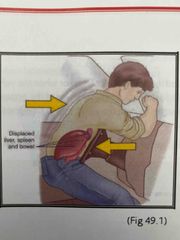
Occupants momentum sends them up and over and hits steering wheel and could cause serious internal damages for example a displaced liver, displaced bowel or abdominal swelling |
|
|
Explain what could potentially happen in an up an over in a frontal collision |
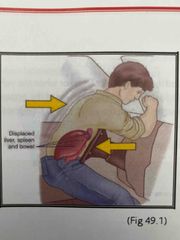
Occupants momentum sends them up and over forcing a collision between the occupant and the steering wheel and could potentially cause a displaced bowel, Displaced liver or severe internal bruising or bleeding |
|
|
Explain what could potentially happen in an down and under in a frontal collision |
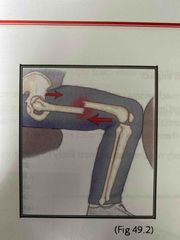
Occupants momentum will send them down and under inflicting force on the thighs and legs and could potentially break a leg bone |
|
|
Explain what could potentially happen during a rear impact |
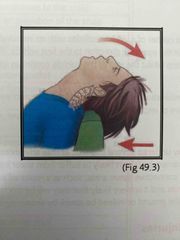
When a stationary vehicle is hit by a moving vehicle energy is transferred to the stationary vehicle sending their body forward and keeping their head stationary causing neck and back injuries |
|
|
Explain what could happens during Lateral Impact |
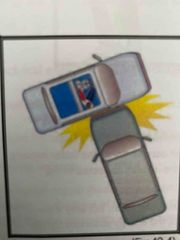
During lateral impact the side of the vehicle absorbs a thrusting force sending unsecured occupants to the area of collision. All occupants absorbed in lateral collision should be treated for spinal injuries unless ambulance paramedics advice otherwise. |
|
|
What are the 5 types of internal bleeding |
•Hematemesis- Vomiting blood •Haematuria- Passing blood in urine •Haemoptysis- Coughing blood •Malena- Passing blood in stool •Brain- blood and/or Cerebral fluid escaping through ears, eyes or nose |
|
|
What are the 3 types of external bleeding |
•Capillary- mixture of oxygenated blood and deoxygenated blood so it varies in colour. Blood escapes in low quantities •Aterial- high pressures oxygenated blood. Bright red in colour pumped out and can be fatal in minutes Venous- Darker red in colour because it is deoxygenated blood. Low pressure do it flows out freely. Can be fatal especially in legs |
|
|
What are the different types of wounds |
•Abrasions- friction on skin caused by scrubbing •Lacerations- a cut caused from blunt trauma leaving jagged edges difficult to close •Incisions- Caused by sharp equipment (clean cuts) Puncture- pointed objects like knives or nails. NEVER REMOVE AND EMBEDDED OBJECT. Gunshot- Cuses two woulds small entry large exit Avulsion- Flap of skin partially or completely torn Amputation- complete separation on body part Crush- Compressive pressure |
|
|
What are the different types of wounds |
•Abrasions- friction on skin caused by scrubbing •Lacerations- a cut caused from blunt trauma leaving jagged edges difficult to close •Incisions- Caused by sharp equipment (clean cuts) Puncture- pointed objects like knives or nails. NEVER REMOVE AND EMBEDDED OBJECT. Gunshot- Cuses two woulds small entry large exit Avulsion- Flap of skin partially or completely torn Amputation- complete separation on body part Crush- Compressive pressure |
|
|
What are the steps to follow when Managing Bleeding |

Back (Definition) |
|
|
What are the steps to take when managing Catastrophic Haemorrhage |
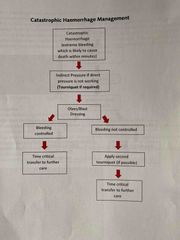
Back (Definition) |
|
|
What is the purpose of using the SOF Tactical Tourniquet Wide |
Used to restrict blood flow to limbs during life saving circumstances |
|
|
Where on the treatment report form do you record information on the usage of the tourniquet |
“Any other details/ Treatment given” section of the form Time applied and limb used on must be recorded |
|
|
Where on the treatment report form do you record information on the usage of the tourniquet |
“Any other details/ Treatment given” section of the form Time applied and limb used on must be recorded |
|
|
Where on the treatment report form do you record information on the usage of the tourniquet |
“Any other details/ Treatment given” section of the form Time applied and limb used on must be recorded |
|
|
What are the steps for Adult basic Life support (2 person) |
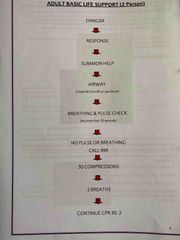
Back (Definition) |
|
|
During sudden cardiac arrest what are the two shockable rhythms that the AED will advice a shock to what are they called |
•Ventricular Fibrillation (VF) •Pulseless Ventricular Tachycardia (Pulseless VT) |
|
|
During sudden cardiac arrest what are the two shockable rhythms that the AED will advice a shock to what are they called |
•Ventricular Fibrillation (VF) •Pulseless Ventricular Tachycardia (Pulseless VT) |
|
|
During sudden cardiac arrest what are the two shockable rhythms that the AED will advice a shock to what are they called |
•Ventricular Fibrillation (VF) •Pulseless Ventricular Tachycardia (Pulseless VT) |
|
|
What are the two non-shockable rhythms the AED will advice against shocking |
•Asystole •Pulseless Electrical Activity |
|
|
What is the Zoll AED |
It is an automated external defibrillator that is designed to give a shock to both adults and children under sudden cardiac arrest |
|
|
What are the names of the different pads on the AED |

Back (Definition) |
|
|
What are the steps in Paediatric life support |
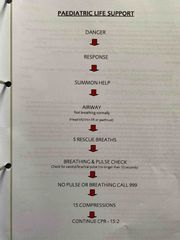
Back (Definition) |

